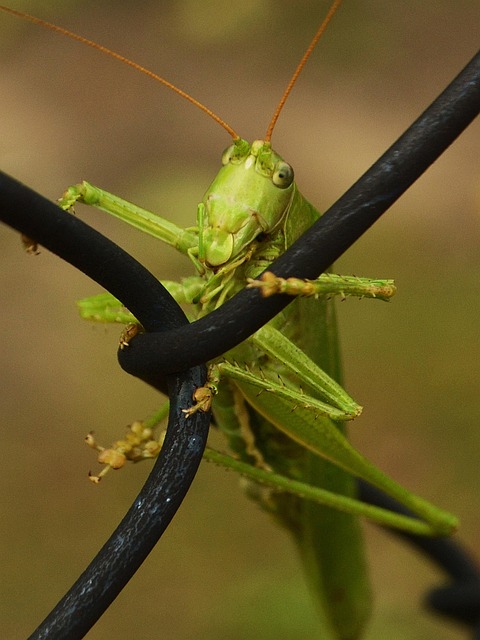Cricket infestations in homes are driven by warm, moist environments with food sources. Early identification through signs like holes and chirping is key for successful removal. Prevention involves sealing entry points, regular cleaning, and targeted insecticide treatments by professionals. Long-term strategies include a clutter-free outdoor space, natural repellents, landscaping modifications, proper waste management, and regular inspections to deter crickets from entering homes.
Crickets infiltrating your home? Discover effective strategies to manage and eliminate these persistent pests. This comprehensive guide explores cricket infestations in residential areas, offering both indoor and outdoor treatments. Learn tailored tactics for swift removal indoors, while understanding preventive measures outside. From long-term solutions to sustainable control methods, this article equips you with the knowledge to reclaim your space from crickets, ensuring a pest-free home environment.
Understanding Cricket Infestations in Residential Areas
Cricket infestations in residential areas can be a common nuisance, often posing challenges for homeowners. Understanding these infestations is the first step towards effective management. Crickets are attracted to warm, moist environments with ample food sources, making homes an ideal habitat, especially during warmer months. They tend to lurk in dark, secluded spaces like cracks, corners, and closets, feeding on organic matter, fabrics, and even paper products. Identifying their presence early is crucial for successful residential cricket removal.
Homeowners should be vigilant for signs such as small holes in fabrics, chewed edges on items like books or clothing, and the distinct chirping sounds that many species produce. Regular inspections, especially in areas with high moisture content like kitchens, bathrooms, and utility rooms, can help detect infestations at their source. Prompt action is key; left untreated, crickets can quickly multiply and spread throughout a home, making comprehensive treatment essential for long-term residential cricket control.
Indoor Treatment Strategies for Effective Cricket Removal
Crickets thriving indoors can be a significant nuisance, but effective management strategies exist for seamless residential cricket removal. Starting with identifying and sealing entry points is crucial to prevent new infestations. This includes checking for small cracks or gaps around windows, doors, and utility pipes, using caulk or other suitable materials to close them off. Regular vacuuming and sweeping also help remove crickets and eggs from floors, carpets, and dark corners.
In addition to physical barriers, indoor treatments involve targeted applications of insecticides. Professional pest control services offer safe and effective options tailored for cricket removal. These treatments often include the use of liquid or powder insecticides applied to hiding places and areas where crickets are most active. Following application instructions carefully ensures the safety of residents and pets while maximizing the effectiveness of the treatment.
Outdoor Measures to Prevent and Manage Crickets
Crickets thriving in your outdoor space? It’s time to take action and implement effective measures for residential cricket removal. Start by maintaining a clean and clutter-free environment, as crickets are attracted to piles of leaves, grass, and wood. Regularly trim vegetation and mow lawns to reduce hiding spots and food sources. Seal cracks and gaps in walls, foundations, and doors to prevent these pests from entering your home.
Consider using natural repellents like citronella plants or lavender to deter crickets without harmful chemicals. For a more robust approach, explore outdoor insecticides targeted at crickets, applying them according to the manufacturer’s instructions. Regular inspections and prompt treatment are key; identifying cricket activity early can prevent an infestation from escalating indoors.
Long-term Solutions for Sustained Cricket Control
Implementing long-term solutions for cricket control is essential for sustained pest management in both indoor and outdoor environments, particularly in residential areas. Beyond quick fixes, these strategies aim to create an environment that discourages crickets from thriving. One effective method is to address the underlying conditions that attract them; sealing entry points, improving ventilation, and reducing moisture levels can significantly deter crickets from entering homes or buildings. Regular inspections and maintenance are key to identifying and rectifying potential access points before they become habitats.
For outdoor spaces, landscaping modifications can be powerful tools in residential cricket removal. Keeping grass mowed and shrubbery trimmed reduces hiding spots, while strategically planting specific herbs and flowers known to repel crickets can create a natural barrier. Additionally, proper waste management and timely cleanup of fallen leaves or debris eliminate potential food sources, disrupting the cricket life cycle and discouraging their presence over time.
Cricket infestations in residential areas can be effectively managed through a combination of indoor and outdoor treatments. By implementing both short-term strategies like indoor pest control methods and long-term solutions focusing on outdoor prevention, homeowners can achieve sustainable cricket removal. Regular maintenance and an integrated approach ensure a cricket-free environment, enhancing the comfort and hygiene of your living space. Remember, proactive measures are key to keeping these pests at bay.
